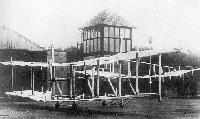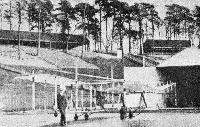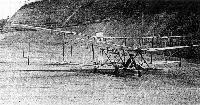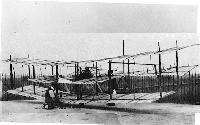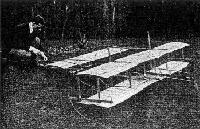
Описание
Страна: Великобритания
Год: 1907
Единственный экземпляр
A.Jackson Avro Aircraft since 1908 (Putnam)
Roe I Biplane
A. V. Roe’s first man-carrying aircraft was a canard biplane of wire braced, wooden construction, similar to the Wright-type model with which he won £75 at Alexandra Palace in April 1907. The aircraft was built round a large white wood, three bay, triangular structure mounted on four homemade pneumatic tyred wheels, the front pair being steerable. The pilot sat in the forward part of the machine and a 6 hp J.A.P. air-cooled motorcycle engine was situated amidships, driving a 6 ft 2 in diameter two bladed paddle-like pusher airscrew of 3 ft pitch through five feet of extension shafting which formed the apex of the central structure. Wing construction was primitive, the kauri main spars being external and therefore thin to reduce drag. For rigidity it was necessary to employ a large number of bracing wires and kingposts with the result that the cotton covering could only be applied to the underside of each wing, the erroneous belief being that lift was only generated by pressure on the undersurfaces. The covering was then tightened with a coat of size and the whole wing structure braced from three much taller kingposts. There were no ailerons and no rudder but a car-type steering column warped and pivoted the large front elevator and so gave both lateral and fore-and-aft control. A. V. Roe was the true inventor of the single-lever type of control and had patented such a system as early as 1906, ante-dating the claims of Continental inventors by several years.
The Roe I biplane was built in the stables behind the surgery of A. V. Roe’s brother Dr. S. Verdon Roe at 47 West Hill, Putney, London, and on completion in September 1907 was taken to Brooklands, where Roe hoped to make an attempt to win at least two of the prizes on offer for successful powered flight. The Brooklands Automobile Racing Club had offered £2,500 for the first flight round their three-mile circuit before the end of that year, stipulating that it should be completed at not less than 10 mph and at a height of between 30 and 50 ft, and The Graphic and Daily Graphic were offering £1,000 ‘to the inventor who first produces a machine which, being heavier than air, shall fly, with one or more human passengers, between two given points not less than one mile apart.’
Although a great deal of taxying was done along the concrete track, the 6 hp engine was not powerful enough and the biplane flew only when towed by friendly racing motorists. Such flights were successful on straight tows, but turns resulted in sideslips and damage until Roe designed a quick-release which enabled him to cast off at will and make controlled landings. In this way he learned the feel of the controls but the end of the year came without the prize being awarded.
‘A. V.’ then negotiated the loan of a 24 hp Antoinette eight cylinder, water-cooled engine designed and built in France by Levasseur. It had copper water jackets and direct petrol injection and on its arrival in May 1908, gave Roe the extra power he so badly needed. To carry the increased weight, extra wing area was provided by inserting short stub wings at mid gap in the inner wing bays. Unfortunately the extra power was more than his airscrews could absorb and many blade failures occurred, but the trouble was eventually cured and in the early morning of June 8, 1908, he succeeded in taking the biplane off under its own power and in making several hops at a height of 2 to 3 ft. above the track. A. V. Roe did not publicise his achievement and two years passed before he let it be known that he had left the ground in 1908. In 1928-29 the Gorrell Committee of the Royal Aero Club disallowed his claim to have been the first to fly in Britain on the grounds that he had not been airborne for a sufficient distance, ruling that the first Briton to do so had been J. T. C. Moore-Brabazon in a Voisin biplane at Eastchurch nearly a year later.
During his long stay at Brooklands, Roe received no encouragement from his landlords. Indeed, the Clerk of the Course, E. Rodakowsky was at times openly hostile to aeroplanes, and at the start of the 1908 motor racing season insisted that Roe’s shed be painted dark green and be moved from its original site alongside the finishing straight, close to the judge’s box, to the other side of the paddock. The shed was also pressed into service as a refreshment room on race days and it was on the first such occasion that Rodakowsky ordered Roe’s biplane to be lifted over 5 ft railings into an adjoining field. During this exercise, track attendants stumbled under the load in the gusty conditions and dropped the machine into a dried-up dyke breaking some ribs. Some further damage was caused by mishandling but the machine was repaired and six trials were possible before Roe was evicted from Brooklands on July 17, having been given two weeks’ notice on July 4. The Antoinette engine was then returned to France as Roe could not afford to buy it and the biplane dismantled. A wheel and a few other selected parts were kept by Roe to remind him of some of the ingenious constructional methods he had used. In later years these items were preserved in a glass case at his home as part of the Roe private aeronautical collection.
SPECIFICATION AND DATA
Construction: By A. V. Roe at 47 West Hill, Putney, London, S.W.15
Power Plants:
One 6 h.p. J.A.P.
One 24 h.p. Antoinette
Dimensions:
Span 36 ft (upper wing) 30 ft (lower wing)
Length 23 ft.
Weights:
Tare weight 350 lb. All-up weight 650 lb.
Weight of Antoinette engine (without radiator) 98 lb.
Описание:
- A.Jackson Avro Aircraft since 1908 (Putnam)
- M.Goodall, A.Tagg British Aircraft before the Great War (Schiffer)
- P.Lewis British Aircraft 1809-1914 (Putnam)
Фотографии
-
M.Goodall, A.Tagg - British Aircraft before the Great War /Schiffer/
The Roe I biplane at Brooklands in 1908 showing the 9 h.p. twin cylinder J.A.P. engine amidships.
-
A.Jackson - Avro Aircraft since 1908 /Putnam/
A. V. Roe with his biplane in the famous ‘Avroplane’ shed at Brooklands in December 1907.
-
P.Lewis - British Aircraft 1809-1914 /Putnam/
A. V. Roe and his first aeroplane in his hed at Brooklands in 1908.
-
Jane's All The World Aircraft 1913 /Jane's/
AVRO (1906). This 24 h.p. biplane, designed by A.V. Roe, was the first British machine to leave the ground.
-
P.Jarrett - Pioneer Aircraft: Early Aviation Before 1914 /Putnam/
A V Roe in his first aeroplane, powered by a 6hp JAP engine, on the 'pull-up' at Brooklands in 1907. Its close resemblance to the model is evident.
-
P.Lewis - British Aircraft 1809-1914 /Putnam/
Avro Biplane I with 9 h.p. J.A.P. at Brooklands.
-
P.Lewis - British Aircraft 1809-1914 /Putnam/
A. V. Roe working on the Roe I biplane after it had been fitted with a 24 h.p. eight cylinder Antoinette engine. AV Roe may have flown on this, his first machine, after fitting an Antoinette engine in 1908, but not officially.
-
P.Jarrett - Pioneer Aircraft: Early Aviation Before 1914 /Putnam/
Many pioneers relied upon models rather than windtunnel experiments. Here, A. V. Roe tends to the large rubber-powered pusher biplane model, one of several he tested, that formed the basis of his first full-size aeroplane.
-
A.Jackson - Avro Aircraft since 1908 /Putnam/
A.V. Roe with his 1907 prize winning model.
-
Jane's All The World Aircraft 1913 /Jane's/
1908 AVROE biplane - was longtime considered the first flying British plane
Country of Origin: U.K. Designed and built by A.V.Roe
Span: 33'3" Length: 23' Weight: 600 lb

